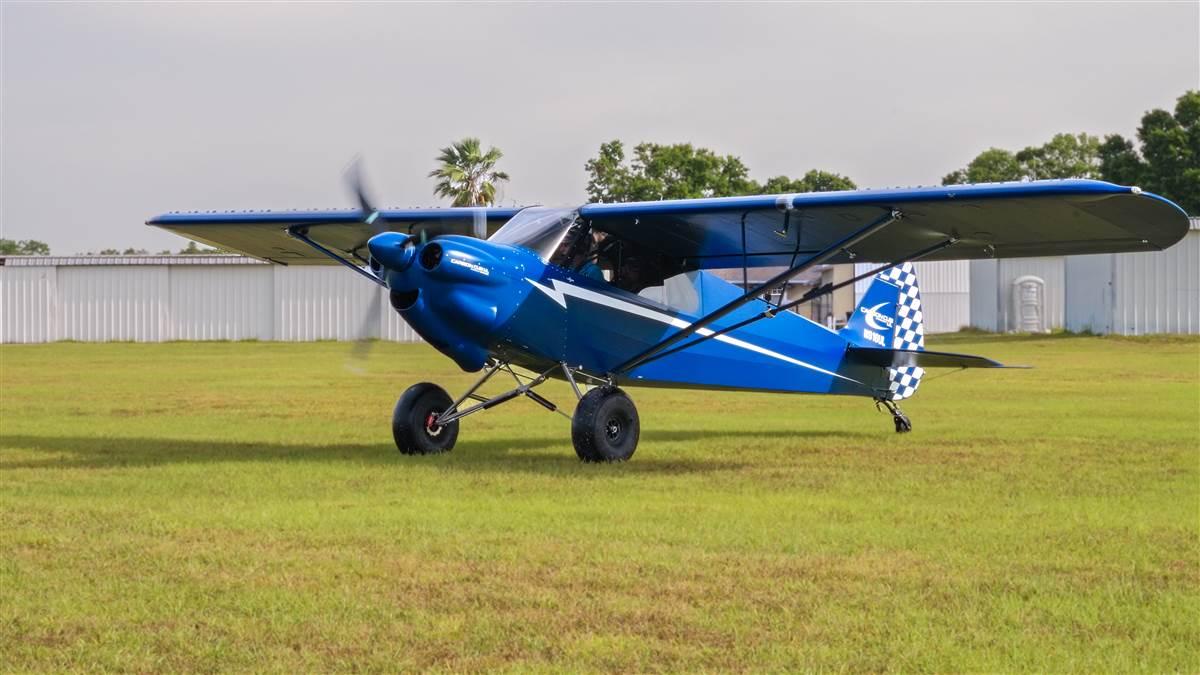Carbon Cub UL
Designed for Europe with universal appeal

The Carbon Cub UL vaults from the turf runway and rises like an express elevator despite the weight of two full-size American men and nearly full fuel tanks. Tall trees at the departure end of the 2,400-foot strip that had seemed imposing a minute before pass by with irrelevance about 800 feet below.
I hold the Carbon Cub UL at something like its 70-mph best-rate-of-climb airspeed but mechanical turbulence on this windy morning makes the vertical speed indication erratic, and it varies between 1,000 and 1,500 feet per minute.
“Pretty good for a 900-pound airplane,” says Brad Damm, CubCrafters vice president for sales and marketing, who flew this airplane to Florida from the CubCrafters factory in Yakima, Washington. “It’ll make full-rated power all the way up to 15,000 feet if you want to go that high.”
The Carbon Cub UL is powered by a turbocharged 160-horsepower Rotax 916 engine turning an MT constant-speed propeller. It was designed for the international market, and it meets European “ultralight” (hence the “UL” name) regulations. But it’s likely to win over plenty of American pilots, too.
The UL has much in common with the Carbon Cub SS, the company’s pioneering light sport model. The UL ditches the 180-horsepower Titan CC340 engine and a fixed-pitch propeller from the SS, however, in favor of an Austrian Rotax and a German MT. Other European components include a Trig radio (Scotland), Beringer wheels and brakes (France), and Oratex fabric (Germany).
Damm said he flew most of his long trek to Florida at 11,500 feet and 145 miles an hour true airspeed while consuming 8.2 gallons of premium car gas per hour.
“I grew up flying Cubs and Super Cubs with long props, so the idea of keeping up with Cessna 182s and passing 172s makes me giggle,” he said.
Slow flight and stalls in the UL seem identical to the Carbon Cub SS. With engine power at idle and full back stick, the airplane just mushes. It takes significant engine power and an exaggerated nose-up attitude to produce an actual stall break, and that’s true with or without flaps.
Flap settings are 15, 30, and 50 degrees, and flaps are actuated via a handle in the upper left corner of the cockpit.


The UL has both a traditional stall warning system and an angle of attack (AOA) indicator. The stall warning horn typically sounds well before reaching the critical AOA, so Damm counsels relying on the more precise AOA indication on the Garmin G3X primary flight display. The three-blade constant-speed prop is controlled via a single power lever so there’s no independent prop knob.
The relatively narrow engine and cowl provide exceptional visibility over the nose. The engine/prop combination is quite smooth and allows rapid acceleration and deceleration. The liquid-cooled engine doesn’t mind rapid throttle changes or making plunging descents at idle power.
Damm advises flying final approach at 45 miles per hour with full flaps, and that’s what I do. It feels like a crawl because of a quartering headwind that reduces groundspeed to just 35 miles per hour, but the AOA indication shows lots of stall margin.
The airplane touches down in a three-point attitude at about 35 mph indicated and decelerates quickly on the soft grass and spongy 26-inch tires.
I shut down at the tiedowns and thank Damm for the demo, and he tells me it doesn’t have to end yet. He hops out and offers to let me fly solo, and that’s something I simply can’t pass up. Predictably, the lightly loaded UL is even more energetic, and the trees at the end of the runway aren’t even a factor when starting the takeoff roll near mid-field.
Although designed for the European market, the UL’s efficiency, preference for unleaded fuel, high-altitude performance, and load-carrying capability have universal appeal. It’s often said that there’s “no replacement for displacement”—but there’s no substitute for light weight, either.
The UL handles beautifully. It carries its own empty weight in payload (both are 900 pounds). And its turbocharged engine seems ideal the hot-and-high conditions of the Mountain West. Those factors would surely have appealed to Jim Richmond, the late CubCrafters founder, who was a minimalist at heart.
“Jim would have absolutely loved this airplane,” Damm said. “It’s got all the attributes he valued most in a backcountry airplane.” 



